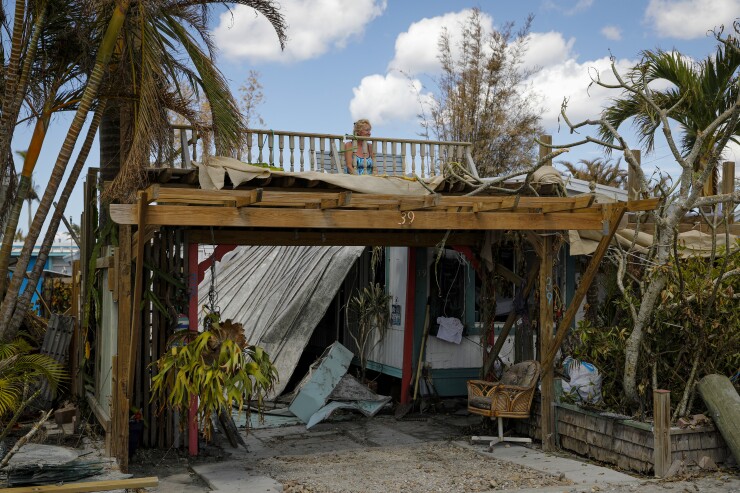Florida took the long view on its $1 billion Cat fund bond sale
6 min read

While there are thousands of municipal bonds sold in the marketplace each year, some require more care and attention than others to turn into successful offerings. Some require constant refinement and retuning right up to the point of sale before it can become a successful offering for issuer, underwriter and buyer.
Such was the case when Florida downsized and restructured and then restructured again a $1 billion taxable bond deal to meet the sweet spot of market demand in the current higher interest-rate environment.
The State Board of Administration Finance Corp.’s sale of Series 2024A revenue bonds for the Hurricane Catastrophe Fund came in a 10-year bullet maturity. However, the deal
Donna Alberico
Closer to the April 18 sale date, the issuer restructured the deal, still at $1.5 billion, into only five- and 10-year maturities with $500 million of five-years and $1 billion of 10-years, before finally settling on a single $1 billion maturity.
The state trust fund provides reimbursements to residential property insurance companies for a portion of their catastrophic hurricane losses in Florida, and it taps the bond market from time to time for liquidity.
“We started out targeting
He said the bonds started out pricing at 100 basis points over the comparable Treasury, but also had about 85 different accounts participate.
“We were two times oversubscribed,” he said. “So we had over $1.9 billion in orders — and that was after we downsized it.”
He noted the deal was originally structured with five-, seven- and 10-year maturities to stagger the due dates so the deal didn’t mature all at one time.
“But when we started looking at it — and we had arbitrarily started at $500 million for each maturity — the feedback we were getting was that the sevens were too much of an off-the-run print for their taste and that people were really looking for fives and 10s.”
So he said they decided to just offer $500 million of fives and $1 billion of 10s.
“The reason we then just decided to go for only 10s was because the rate on 10-years was roughly equivalent to the five-years,” he said. “We were really looking for a more permanent source of funding liquidity in the capital stack. So if it’s not costing you any more to go longer, we clearly had a preference to go longer.”
He also noted the sale was a “want to have, not a need to have,” meaning that the fund would be okay and in good shape even without the infusion of extra cash.
He said the only downside was as to timing — it was a higher rate environment for this sale than it was four years ago when the Cat fund sold $3.8 billion of bonds.
“We had no real targeted amount this time,” he said. “So with interest rates as high as they were, we decided to just put $1 billion on the books.”
He said the money “is just going to sit there now anyway, we don’t expect to need it. So there was no reason to embed that higher interest cost for 10-years on a larger amount.”
“We started out at plus-100 basis points and after everything was said and done we ended up at plus-93 basis points over Treasuries, so were able to tighten a bit,” he said.
He noted that there has been no significant secondary market trading in the issue.
“We view this as positive,” Watkins said. “The bonds found a home with buy-and-hold investors and that’s really what we’re looking for — people who own the credit, understand the credit over the long term.”
The 10-year Series 2024A bonds were priced at par to yield 5.526%.
Morgan Stanley was senior bookrunning manager with BofA Securities, J.P. Morgan and Wells Fargo action as co-senior managers. Raymond James was the financial advisor; Nabors, Giblin & Nickerson was the bond counsel.
The deal was rated Aa3 by Moody’s Ratings and AA by S&P Global Ratings, Fitch Ratings and Kroll Bond Rating Agency. All four rating agencies have stable outlooks on the credit.
Proceeds of this sale will go to the Cat fund to make reimbursement payments to insurers for reimbursable losses caused by any future covered events.
Proceeds of the sale will also replace some of the $1.25 billion of bonds that are coming due from the previous sale almost four years ago.
Those bonds were priced by BofA Securities at par in 2020, reflecting a far different rate environment. The 5-year yielded 1.125%, or 100 basis points over the comparable U.S. Treasury security, and the 10-year yielded 2.154%, or 150 basis points over Treasuries.
The state created the Cat fund to provide a stable and ongoing source of loss reimbursement for residential property insurers. It functions like a private reinsurer by collecting premiums from residential property insurers and reimbursing them for covered residential losses, according to its online investor presentation.
It has statutory authority to levy assessments on property and casualty insurance policyholders in Florida after any large insurance-covered event that exhausts the Cat Fund’s cash resources to pay debt service on pre-event or post-event bonds and reimburses insurers for losses.
Both the Cat Fund and Citizens Property Insurance Corp., the state-owned insurer, can levy assessments, subject to a cap, on almost all property and casualty insurance policies to pay claims. In Florida, participation in the fund is mandatory for almost all residential property insurers; the fund’s liability is statutorily limited.

Bloomberg News
Florida has weathered several of hurricanes in the past few years.
In comparison, the damage and economic loss from
This was the first time KBRA rated the credit.
KBRA said its AA rating reflected the
The credit has many strengths, said Linda Vanderperre, senior director at KBRA.
“The assessments are so broad-based and can be levied on a very diverse property and casualty policy base and they’re levied directly to policyholders, available for debt service for both pre-event and post-event parity obligations,” she told The Bond Buyer.
She noted the Cat fund was an essential component to the state’s healthy economic growth and continuing ability to function with a healthy property insurance market.
“We see the essentiality of the Cat fund as integral to maintaining the ability in that market to be part and parcel of the state’s ability to grow,” she said.
Some of the challenges include the possibility that if several storms hit Florida over the next several years it could increase the likelihood of post-event borrowing, KBRA said, which could be large.
Watkins said
“The big picture perspective is that the litigation reforms are working and that’s a big deal for the marketplace in general,” Watkins said.
“It eliminates some of the excessive litigation and we see this as new entrants are coming into the insurance market,” he said. “We’ve got eight new companies and this is combined with the depopulation of Citizens, which was down 250,000 policies by the end of 2023 and they expect to be down an additional 350,000 in 2024.”
He said there are no plans to sell more debt for the Cat fund this year. It was authorized







